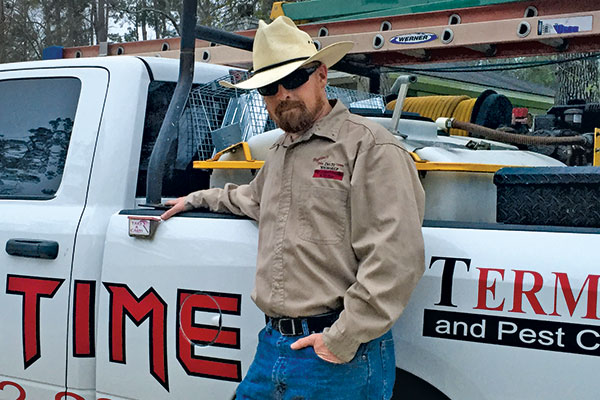Bugtime Pest Control’s Jeff Nation had a bad feeling about the obscure Texas leafcutter ant.

About 80 percent of the half-acre yard was covered in nests he could see before he even pulled into the driveway.
MASTER: Jeff Nation, Service Manager, Bugtime Pest Control, Humble, Texas
INVADING SPECIES: Texas leafcutter ant (Atta texana)
WAR STORY: 80 percent of yard covered by nests of species he was fairly unfamiliar with.
WINNING WAY: Non-repellents on mounds, trails, foliage they favor.
Photo: Bugtime Pest Control
With more than 700 species of ants crawling throughout the United States, it’s difficult for pest management professionals (PMPs) to know how to identify and best treat them all.
For example, unless a PMP works in rural Texas, he may never come across the Texas leafcutter ant (Atta spp.).
Jeff Nation, service manager for Humble, Texas-based Bugtime Pest Control, came across Texas leafcutter ants about five years into his pest management career. A customer located in a rural part of town called the company after she and her husband couldn’t get rid of the ants.
When Nation arrived at the home, he saw why: About 80 percent of the half-acre yard was covered in nests he could see before he even pulled into the driveway.
“They were concerned,” Nation reports. “They had this massive ant problem and they had been buying product at Home Depot and Wal-Mart, and nothing was doing anything. They didn’t know what to do.”
Neither did Nation, at first. So he made a few phone calls, seeking advice. A manufacturer’s rep asked Nation to describe what he saw, and solved the mystery.
He now knows the Texas leafcutter ant is primarily a problem in the Lone Star State, although they also can be found in Louisiana and Mexico. This species feeds on fungus they make by stripping the leaves off plants and trees and piling up the foliage in their chambers.
Adjusting the size of their nest entrance holes helps keep the temperature there a constant 70°F, which makes fungus grow on the leaves. The ants typically tunnel about 20 ft. to reach the desired temperature during hot Texas summers.
At the account, several of the mounds were situated along the home’s perimeter, which was on a concrete slab, and ants were entering the house.
“That’s not typical,” Nation adds. “Because the mounds extended so far underneath the house, ants were coming up in some of the wet areas, like from underneath the tub and shower.”
Using trial and error, Nation eventually figured out how to eradicate the pests. He aggressively applied a repellent — twice — but fell short of obtaining complete control.
Then by chance, he received a sample of a non-repellent that he had never used. A handheld tank, 1 gal. of product, and a pinstream shot in the hole of each mound was all it took to finish off the Texas leafcutter ants that remained on the property.
“Since then, I’ve learned that going at Texas leafcutter ants with non-repellents often is far more effective,” he says. “Typically, when I treat them now, I never have a callback. It’s just one and done.”
After 15 years in the business, Nation now advises other PMPs dealing with Texas leafcutter ants to stop their protocol and switch to his control method. He tells them to stick with non-repellents that can be transferred from ant to ant. He also recommends they treat the mounds, the trails, the foliage they favor and the ground on which they’re foraging.
You can reach Managing Editor Diane Sofranec at dsofranec@northcoastmedia.net.
Leave A Comment